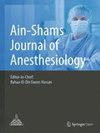Clinical efficacy of local infiltration of lidocaine and tranexamic acid application in tonsillar region on postoperative pain and bleeding during tonsillectomy: prospective, randomized, double-blind controlled study
IF 0.5
Q4 ANESTHESIOLOGY
引用次数: 0
Abstract
Abstract Background Anesthetic techniques are designed to minimize intraoperative surgical bed bleeding which is a major problem that may interfere with precision, surgery duration, or postoperative wound healing. The main reason for reoperation and/or mortality in children who have had tonsillectomies is post-tonsillectomy hemorrhage. We evaluate the local application effect of tranexamic acid and lidocaine local infiltration in the tonsillar bed during tonsillectomy surgery on postoperative analgesia and bleeding. Results FLACC scores showed a statistically significant reduction in the first 24 h in group T ( P < 0.05). Post-tonsillectomy hemorrhage was significantly minimized in group T. No complications were recorded following the local application of tranexamic acid and local lidocaine infiltration inside the tonsil bed. Conclusions Local infiltration of lidocaine provides adequate postoperative analgesia, and tranexamic acid application during tonsillectomy surgery minimizes postoperative bleeding and shortens surgery duration. Trial registration This study was preregistered with the Clinical Trials Registry (NCT05817474).扁桃体局部浸润利多卡因和氨甲环酸应用对扁桃体切除术术后疼痛和出血的临床疗效:前瞻性、随机、双盲对照研究
麻醉技术的目的是尽量减少术中床出血,这是一个可能影响手术精度、手术时间或术后伤口愈合的主要问题。扁桃体切除术后出血是儿童再次手术和/或死亡的主要原因。我们评价扁桃体切除术时扁桃体床局部浸润应用氨甲环酸和利多卡因对术后镇痛和出血的影响。结果T组FLACC评分在治疗前24 h显著降低(P <0.05)。t组扁桃体切除术后出血明显减少,局部应用氨甲环酸及扁桃体床内局部浸润利多卡因无并发症记录。结论局部浸润利多卡因可提供足够的术后镇痛,在扁桃体切除术中应用氨甲环酸可减少术后出血,缩短手术时间。本研究已在临床试验注册中心(NCT05817474)进行预注册。
本文章由计算机程序翻译,如有差异,请以英文原文为准。
求助全文
约1分钟内获得全文
求助全文

 求助内容:
求助内容: 应助结果提醒方式:
应助结果提醒方式:


